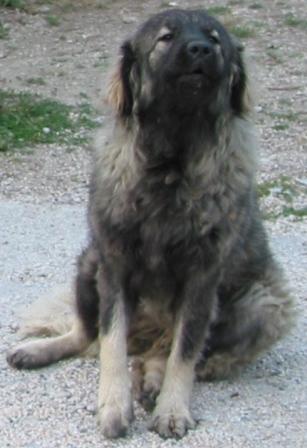
Sarplaninac
Veterinarian Reviewed on December 23, 2007 by Dr. Janice Huntingford
Physical Characteristics
Breed Group:
Guardian dogs.
Weight:
Approximately 66-99 pounds (30-45 kg).
Height:
Approximately 23-24.5 inches (58-62 cm).
Color(s):
This breed comes in solid colours of any shade between white to dark brown.
Coat:
This breed has a thick top coat that is long on the neck and body and short on the head. The top coat is accompanied by a short and thick undercoat.
Overview
Character:
Sarplaninacs are majestic and courageous dogs that don’t back down from threats. Protective yet gentle with familiar people, these dogs are exceptional guardians as well as loyal companions.
Country of Origin:
Former Yugoslavia.
History:
The Sarplaninac is an ancient guardian breed that originated in the southwestern region of former Yugoslavia. While the exact history of this breed is not known, it’s possible that it descended from ancient Molossian breeds of Greece and guardian breeds from Turkey. In any event, it is thought that the Sarplaninac has been in existence for approximately 2000 years. This breed was first registered with the FCI in 1939 and is now gaining popularity in France and other European countries.
Name:
This breed was named for the Šar mountains where it is most commonly found.
Temperament:
The Sarplaninac is an independent dog that has a calm temperament when no threats are present. As an instinctive guard dog, the Sarplaninac is suspicious of strangers and will sometimes be aggressive toward outsiders. While ferocious in the face of a threat and dominant over other dogs, the Sarplaninac is gentle with children. This breed must be trained at a very young age not to kill small animals if it is not to be used for hunting.
Care
Training:
Since the Sarplaninac has such a strong personality, it must receive training at a very young age.
Activity:
This active breed requires considerable exercise as well as access to plenty of open space.
Ownership:
The Sarplaninac can adapt to living indoors but must receive plenty of exercise and have access to lots of open space. If this type of dog is not to be used for hunting, it’s extremely important to train it from a young age not to kill small animals. Sarplaninacs must have frequent companionship, as they hate solitude. This breed requires weekly brushing throughout most of the year and daily brushing during shedding.
Breeders
No breeders listed at this time.
Sign up for our newsletter and receive more articles and the latest pet health updates and special offers.
Our Expert
 Dr. Janice Huntingford
Dr. Janice HuntingfordJanice Huntingford, DVM, has been in veterinary practice for over 30 years and has founded two veterinary clinics since receiving her Doctor of Veterinary Medicine at the Ontario Veterinary College, University of Guelph. She has studied extensively in both conventional and holistic modalities. Ask Dr. Jan

